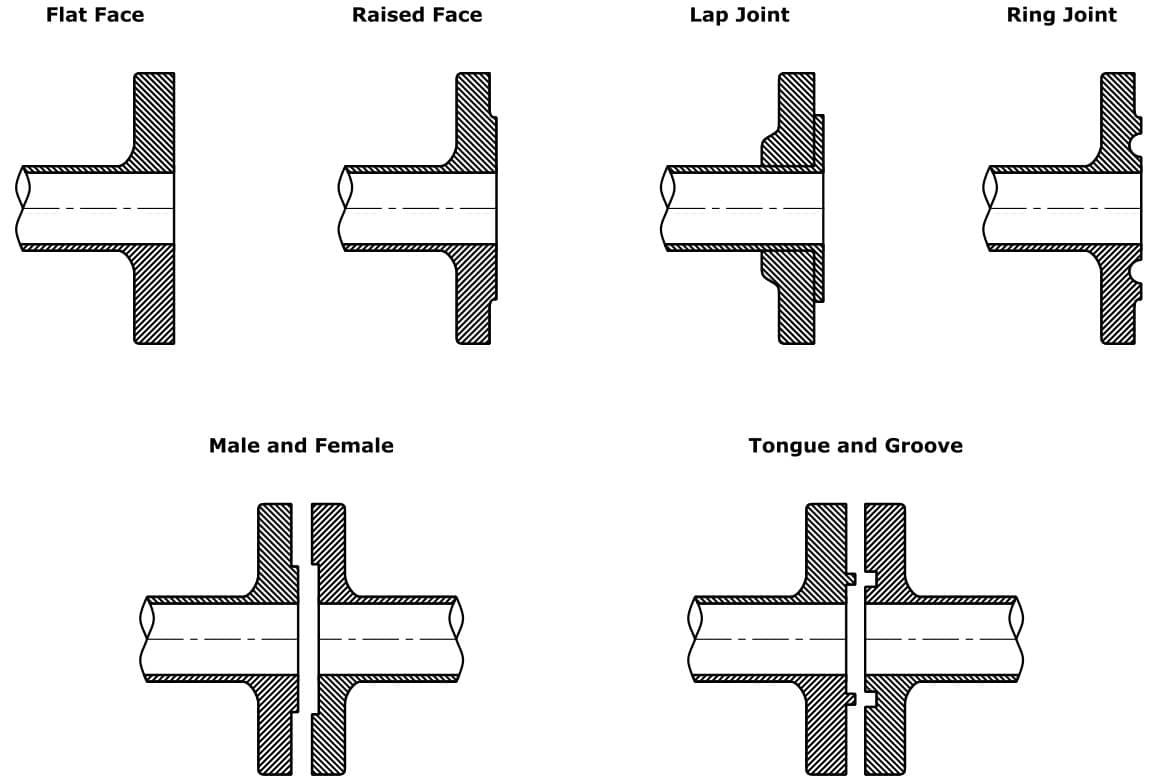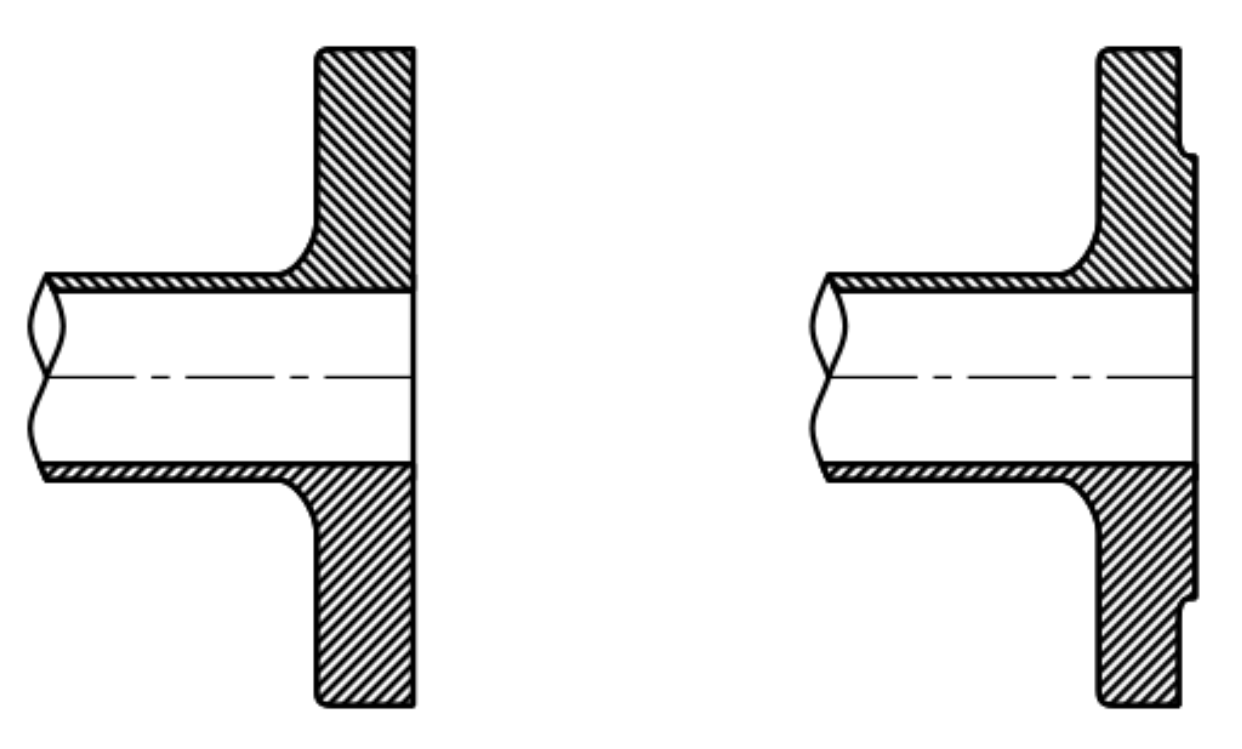What is a flange face?
There are three common types of flange face, the plain/flat, raised, and ring-type joint (RTJ). Other types of flange face exist, primarily the Tongue-and-Groove (T&G), Lap Joint, and Male-and-Female (M&F) designs, but these are less popular. Piping standards define the exact geometry, dimensions, material, and surface finish of a flange face.

Flange Face Types
As a general rule, the smaller the contact surface area between the flange faces, the harder the gasket and flange sealing surface material will be. This is because a smaller sealing face area means a larger pressure can be applied with less force (pressure = force / area). Harder materials require a larger pressure to seal than softer materials, even if the surfaces are ground and lapped before mating. In order to reach higher pressures without needing to apply excessive torque to the fasteners, the contact surface area of the sealing face is reduced in size
For this reason, flat face flanges have gaskets that extend from the flange’s inner diameter to the flange’s outside diameter; these types of gaskets are known as ‘full face’ gaskets and have a large contact sealing area. Raised face flanges only have a gasket on the raised face; these types of gaskets are known as ‘flat ring’ gaskets. For ring-type joint flanges, the sealing area is comparatively small, and the gasket material comparatively hard (metal).
Are you enjoying this article so far? Then be sure to check out our Flange Fundamentals Video Course. The course has over five hours of video content, a 52 page colour illustrated handbook (this article is an extract from the handbook), a quiz, and you will receive a certificate of completion when you finish the course. Enjoy!
Plain Face/Flat Face (FF)
Flat face (FF) flanges use non-metallic gaskets (soft gaskets) and should always have a serrated sealing surface. This type of flange is well suited to low pressure applications and is used for pressure classes 125 and 250.
Gaskets are installed directly on the front sealing face of the flange blade i.e. on the same plane as the bolting circle face. The gasket sealing area is from the inner flange diameter to the outer flange diameter. Typical soft gasket materials are usually rated to 100⁰C (212⁰F) and not more than 20 bar (290 psi) pressure. Because flat face flanges use such a large sealing area, they are made to fit. Flat face flange gaskets cannot rotate once installed due to the bolt hole penetrations through the gasket. Due to the large size of the sealing face, flat face flanges are resistant to mechanical distorting (bending, bowing etc.).
Flat face flanges should never be mated with raised face flanges, particularly if the raised face flange is manufactured from a harder material.

Flat Face Flange (left) and Raised Face Flange (right)
Raised Face (RF)
A raised face (RF) flange has circular shaped sealing face that protrudes from the flange’s bolting circle plane. Raised face flanges are available in all pressure classes, and thus for a wide range of pressure and temperature ratings. RF flanges are the most common type of flange employed in the Oil and Gas and chemical engineering industries.
RF flanges use serrated sealing surfaces with non-metallic or semi-metallic type gaskets. The sealing face of an RF flange is from the flange’s inner diameter to the outside diameter of the raised face. A typical gasket for RF flanges would be a graphite steel composition gasket with a temperature rating up to 400⁰C (750⁰F) and a pressure rating of up to 250 bar (3,625 psi).
%20and%20Raised%20Face%20(right)%20Flanges%20and%20Gaskets.png)
Full (left) and Raised Face (right) Flanges and Gaskets
The height of the raised face above the bolting face plane is dictated by the flange’s class and the standard from which it is taken. For the ASME B16.5 standard, steel flanges in classes 150 and 300 have a raised face height of 1/16 inch (1.6mm); steel flanges exceeding class 300 use a 1/4 inch (6.4mm) raised face. In an ideal world, the height of a raised face would increase as the class increases, but this does not occur in most standards; it is however a logical generalisation.
Ring-Type Joint (RTJ)
Ring-type joint (RTJ) flanges are a variation of the raised face flange design. RTJ flanges are typically used for more severe applications, particularly for high pressure systems, and/or high temperature systems (>750⁰C / 1,382⁰F). It is possible to use RTJ flanges across all pressure classes, but they are typically used for class 900 and above.
The difference between an RTJ flange and a raised face flange is the way a seal is obtained. Metal gaskets (hard) are used with RTJ flanges, whilst raised face gaskets use soft or semi-metallic gaskets. There are three main ring type joint groups, these are R, RX and BX; we will focus on the R type joint because it is by far the most common.
R-type RTJ gaskets are circular in shape with an oval or octagonal shaped profile/body; the octagonal profile obtains the most efficient seal and is the more modern design. A groove is machined into the face of an RTJ flange and the associated gasket is installed into this groove. When the flange is assembled, the two mating faces compress the gasket until it deforms and a metal to metal seal is formed. If the flange is assembled correctly, the two mating RTJ flanges should not come into physical contact with each other

RTJ Components (octagonal gasket left, oval gasket right)
RTJ gaskets are often manufactured from a material slightly softer than that of the flange. Because the gasket material is softer, it deforms at a lower pressure than the flange, this ensures that it is the gasket that deforms to make the seal rather than the flange deforming around the gasket.
Flange Face Summary
The below table summarises characteristics of the three most common flange faces.
|
|
Flange Face Type |
||
|
Characteristics |
Flat Face |
Raised Face |
Ring-Type Joint |
|
Sealing Area |
Large |
Medium |
Small |
|
Sealing Face |
Inner diameter to outer diameter. |
Inner diameter to raised face outer diameter. |
Groove in flange face. |
|
Pressure Range |
Narrow. Low pressures only. |
Broad |
Broad. Generally used for higher pressures. |
|
Pressure Class |
125#, 250# |
All. |
All. Generally ≥ 900#. |
|
Temperature Range |
Narrow. Low temperatures only. |
Broad |
Broad |
|
Gasket Type |
Soft. Non-metallic. |
Non-metallic, semi-metallic. |
Hard. Metal. |
Flange Face Characteristics Summary
Flange Types, Faces, and Surfaces - Explained!
This video is part of our Piping Flange Fundamentals Video Course
Related Online Engineering Courses
Introduction to Valves (short course)
Introduction to Centrifugal Pumps
How Multistage Centrifugal Pumps Work
Eductors, Ejectors, Venturi Pumps and Jet Pumps Explained
Additional Resources
http://www.wermac.org/flanges/flanges_raised-face_flat-face_ring-type-joint.html
https://www.kamleshmetal.com/flanges-faces-types.html
https://www.theprocesspiping.com/introduction-to-flanges
